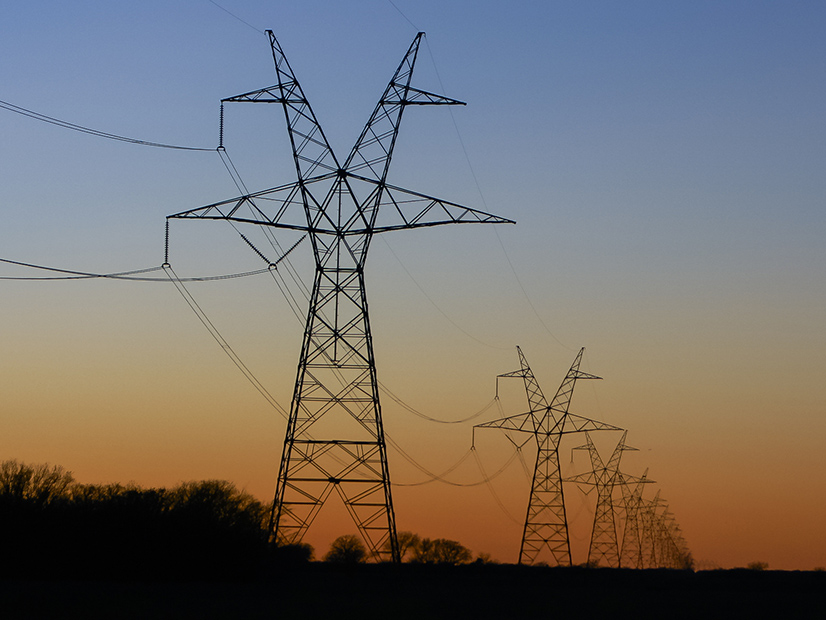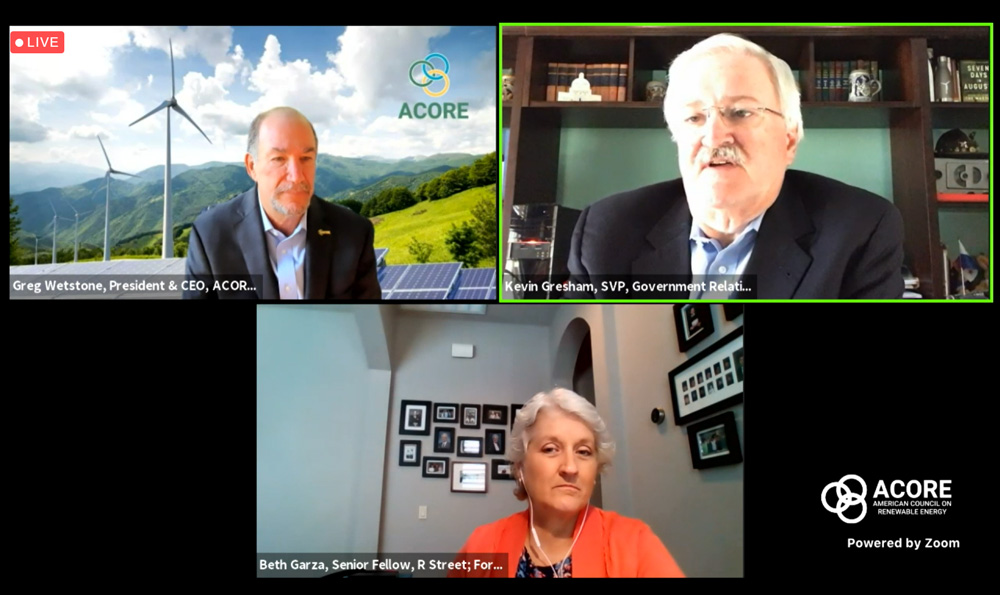
Kevin Gresham and Beth Garza are not overly concerned with ERCOT’s conservation call issued on Monday in the wake of unexpected outages at several thermal generation plants in the state. (See Generation Outages Force ERCOT Conservation Alert.)
Summertime heat and calls for conservation are not unusual in Texas, said Gresham, senior vice president of government affairs at RWE Renewables America and also a member of the ERCOT Board of Directors. Speaking at the American Council on Renewable Energy Finance Forum on Wednesday, Gresham said what makes the current appeal different is that it has come earlier in the season than expected and public concern about any outages is higher following the state’s dayslong blackouts in February.
Another difference: Summertime peaks are more transitory, said Garza, former director of ERCOT’s Independent Market Monitor. “It gets hot in the late afternoon, then builds to a peak, and then the sun will set; it will get cooler,” she said. “Winter is different. It gets cold, stays cold and nighttime gets colder, and you have competition for natural gas.
“It’s time for ERCOT to think about winter differently than summer and its different emergency procedures. You need more notice; you have to take actions earlier in the winter,” said Garza, now a senior fellow at the R Street Institute, a nonprofit policy research organization.
The past and present ERCOT insiders were at the Finance Forum for a frank conversation on the causes and lessons learned from the February outages and whether Texas Senate Bills 2 and 3, signed into law last week by Gov. Greg Abbott, would provide the technical and regulatory fixes needed to prevent future repeats.
Garza quickly nailed down three causes of the February blackouts. First, she said, was the lack of winterization across the power system — not only with transmission and generation facilities, but with homes, transportation and natural gas. Other contributing factors were the “dysfunctional” codependence of the electricity and natural gas industries, and “unbridled” reliance on markets during a clear emergency in which they were ineffective.
Electricity and natural gas “don’t communicate if the two industries work on different time frames, with different expectations, but somehow [they] are dependent on each other,” she said.
Words vs. Electrons
Both Garza and Gresham are taking a wait-and-see approach to the new legislation that came after February’s severe winter weather left hundreds dead and an estimated 4.5 million customers without power across the state. (See Texas Legislators Finish Work on Electricity Market – for Now.)
Gresham noted that SB3 directs the Texas Public Utility Commission to “determine whether or not ERCOT is procuring appropriate ancillary services and allocating them in the right way. So basically, the decision making has shifted venues.”
Stakeholders and advocates, such as ACORE, will “have to have the same level of representation and engagement,” Gresham said.
ACORE took part in industry efforts to oppose provisions in SB3 and other legislation that would have shifted the costs of ancillary services exclusively onto the state’s renewable resources. While the language was removed, the targeting of renewables could now be “moving to the regulatory round with rulemakings,” Gresham said. “There are going to be several that the Public Utility Commission is going to have to take up. The industry and its supporters need to be involved.”
Garza believes the laws will catalyze change, whether good or bad. “It is what it is, and we need to go forward with it,” she said.

SB3 could improve communication between the electricity and natural gas sectors, she said. The law mandates that critical gas facilities be mapped and registered with utility providers to prevent a repeat of the dayslong outages. It also creates a new statewide emergency alert system and brings together electric and natural gas regulators and market participants in a new energy subcommittee.
While requiring generation and transmission to be weatherized, the law limits natural gas weatherization to facilities that regulators consider “critical,” with penalties capped at $1 million a day.
“Continual service of electricity is a physical phenomenon; legislation is words written on paper,” Garza said. “Writing words is not going to necessarily directly affect the physical phenomenon. It takes time to get rules in place.”
Changes at the ERCOT board and the PUC could add more uncertainty and delay to that process. Following the February outages, seven ERCOT board members and all three PUC commissioners resigned. Abbott has since named two new commissioners.
Going forward, SB2 will slim down the ERCOT board from 16 members to 11 and directs that most of the members be appointed by politicians. Previously, a search committee picked five independent directors (those seats have been eliminated) with market segment members electing their representatives.
Another bill, SB2154, would expand the PUC from three members to five and only require two commissioners to be “well informed and qualified in the field of public utilities and utility regulation.” The bill is still sitting on Abbott’s desk.
Dispatchable vs. Renewable
Considering lessons learned — or perhaps to be learned — ACORE CEO Gregory Wetstone brought up a question discussed at length after the February outages: Should Texas expand its regional connections with other grid operators to allow the state to tap into extra power during emergencies?
Garza said her stock answer to that question is “maybe.”
“We wouldn’t build more capacity just to save ERCOT in the wintertime,” she said. “I think the opportunity to build bigger interregional connections is more fueled on the opportunity to sell our vast renewable resources elsewhere,” such as the West Coast, as neighboring SPP already has plenty of wind.

Gresham said the current need is to upgrade or build out the grid to relieve congestion caused by the state’s growing population and economy. “We’re not designing the transmission grid for the past 10 years,” he said. “We’re trying to do it for the next 10, 20, 30, 40 years, which is the life of the investment. That’s a totally different way of looking at it.”
Gresham said the February outages also triggered “a debate here in Texas over dispatchable versus renewable generation, as [if] dispatchable was always exactly what it should be: you put fuel in, and you get X amount. That’s not always the case.”
Output can be affected by weather conditions or a plant’s operational issues, he said. “Those are the types of things grid operators deal with every day,” he said. “As we move forward in a policy sense, people need to recognize and understand that.”
Investors not Fazed by ERCOT
A separate panel during the forum agreed that developers will continue to invest in ERCOT, as evidenced by the 30 GW of renewable energy currently on the ground and with more on the way.
“Twenty thousand megawatts of renewables over the last 10 years … I don’t see that slowing down,” said Peter Freed, Facebook energy strategy manager. “ERCOT remains one of the most affordable markets in the country.”
For now, Facebook is focused on the “meat-and-potatoes regulatory work” taking place inside ERCOT and the PUC. The grid operator’s new board must be in place by Sept. 1, but the commission’s charge to ensure ancillary services are appropriately allocated is expected to last into 2022.
“We’re keeping a very close eye on market reforms at Texas to see how the market operates,” Freed said. “Anyone who’s been in the ERCOT market for a long time is comfortable with those high prices in the summer, though not necessarily in June. There are a lot of things that market participants are thinking about coming into summer and the concurrent regulatory process that’s going to be a big part of the next year, at least.”
Legislators and regulators have declined to take action on ERCOT’s $9,000/MWh cap for energy prices, which produced more than $47 billion in market transactions during the winter storm and sent some participants into bankruptcy.
Marathon Capital’s Joan Hutchinson said that the price cap — limited by rule to $2,000/MWh for the rest of the year after February — and the lack of a capacity market produced different results during the winter storm than would have happened in other grid operators.
“The $9,000 cap certainly makes it more impactful, but all these transactions were entered into by willing buyers and willing sellers and financiers. This was not a risk people were unaware of,” Hutchinson said.
“The key was really whether you were producing at the time. If you were selling at $9,000 or whatever your node price was, you were doing great,” Wells Fargo’s Jordan Newman said. “The problem was, so many generators were unable to produce at the time.”
“The price wasn’t volatile if you generated anything,” Hutchinson said, agreeing with Newman.


